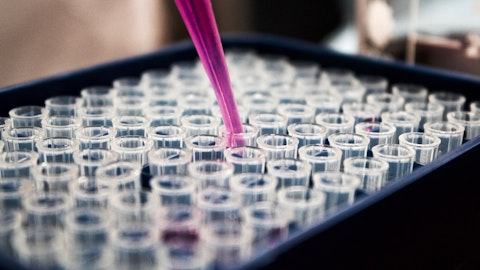So we had really good survival for year one and the first 17 months. What we needed to understand was would we get a significant drop-off after one to two years or would this be a durable response and these patients continue to survive? And what we saw was that all patients who were alive at two years remained alive at three years. That was very important. But what was also very important was the safety, right. So as you may know, our PDS01ADC is an IL-12 based antibody drug conjugate. In the past, recombinant IL-12 have seen significant toxicities, and so one of the key reasons that we needed additional data was really to confirm the safety profile of our IL-12 antibody drug conjugate and also to really confirm that it is significantly different from the recombinant IL-12 that have been evaluated in the past and that continue to be evaluated today, right.
So the safety data from the over 300 patients that we’ve evaluated today was very critical in forming this decision also, really confirming that safety profile and tolerability in these patients who have taken the IL-12 antibody ADC. So that was again very important in this decision-making process also. Now what was also very important is what you just brought up. Is there a clear regulatory pathway for the triple combination? And so that was why we initiated discussions with the FDA to get feedback from the FDA in terms of what they would want to see in a clinical design of PDS01ADC versus HPV and KEYTRUDA. With PDS0101, KEYTRUDA forming the basis for that program, we’ve seen very good survival, impressive survival with just PDS0101 and KEYTRUDA based upon the quality of T-cells that we’re generating and now adding the PDS01ADC on top of that to really overcome the tumors defenses, right.
And so we had that discussion with the FDA last month and the FDA has given us very clear guidance on what they would want to see in the clinical design. So what we are currently doing is implementing the feedback from the FDA, and then once we have done that, we would want to get alignment with the FDA that, okay, we’ve taken these, your advice and guidance into consideration. Here is the trial and get alignment with the FDA. At that point, we will then make the protocol publicly available. But I would hate to go into saying exactly what the design is until we have gotten that alignment with the FDA based upon the feedback they gave us. But that’s the process that we’ve gone through to date.
Mayank Mamtani : Yep. Got it. Very helpful. And then on the opportunity set here, like what specific indication you’re looking as your lead? Is it the same population where you have this data or you’re looking at this more broadly in HPV+ solid tumor types, which there are many? If you can just categorize the broader opportunity set and also like how you get there in terms of different trials you would need, that would be helpful. Thanks again for taking our questions.
Dr. Frank Bedu-Addo: No, Mayank, that’s a really good question. So we have done extensive market research, talking to key opinion leaders to re-understand the potential in both ICI naive and ICI resistant patients. From all the information we’re getting, the KOL see this as potentially very important in both. There are unmet needs in both the ICI naive and ICI resistant patient population. As you know, currently the response rates in ICI naive are only about 20%, significant unmet need there. In the ICI resistant, practically nothing is really working in those patients. Our focus initially guided by the FDA is to focus on head and neck cancer rather than going broadly into all types of HPV associated cancers, which is what we were initially thinking about.
But what we discussed with the FDA and the guidance we’ve been given is let’s focus first on head and neck cancer, which is where we’ve generated the bulk of our data to date, right. Over 110 patients in head and neck cancer patients have been treated with our product today. So we have really good confidence around the head and neck cancer patients. In the NCI trial, of course, we went beyond head and neck cancer to look at other HPV types where we saw responses, equally good responses across the board. And so the way we envision this is let’s first focus on the biggest market and the most rapidly growing market, which is the head and neck cancer space, get that done, and then potentially progress from there into the other HPV cancer tumor types.
But our initial focus is going to be specifically recurrent metastatic head and neck cancer.
Mayank Mamtani : Thank you for taking our questions.
Operator: Thank you. The next question is in the line of James Molloy with Alliance Global Partners. Please proceed with your questions.
James Molloy : Hey guys, good morning. Thank you for taking my questions. So, I apologize, it’s challenging to follow sometimes. So the VERSATILE-003 Phase 3 combo with KEYTRUDA HPV+ head and neck squamous cell, CPI-naive patients, that trial is now shelved or that trial is now ongoing, but you’re adding in the 01ADC, formerly called 0301.
Dr. Frank Bedu-Addo: Hi James. Thanks for your question. So, VERSATILE-003, we’re not performing VERSATILE-003. So based upon the information we have today, our goal as a company is to provide to the patient the drug in combination that we believe provides them with the best opportunity for managing their disease. And today, based upon the information we’ve generated and our understanding of the mechanism by which these assets work, we believe that the triple combination is what provides these patients with the best opportunity to manage the disease. But also what’s very important for us, based upon the key opinion leader research is which combination is really going to put PDS Biotech in a dominant leadership position in head and neck cancer.




